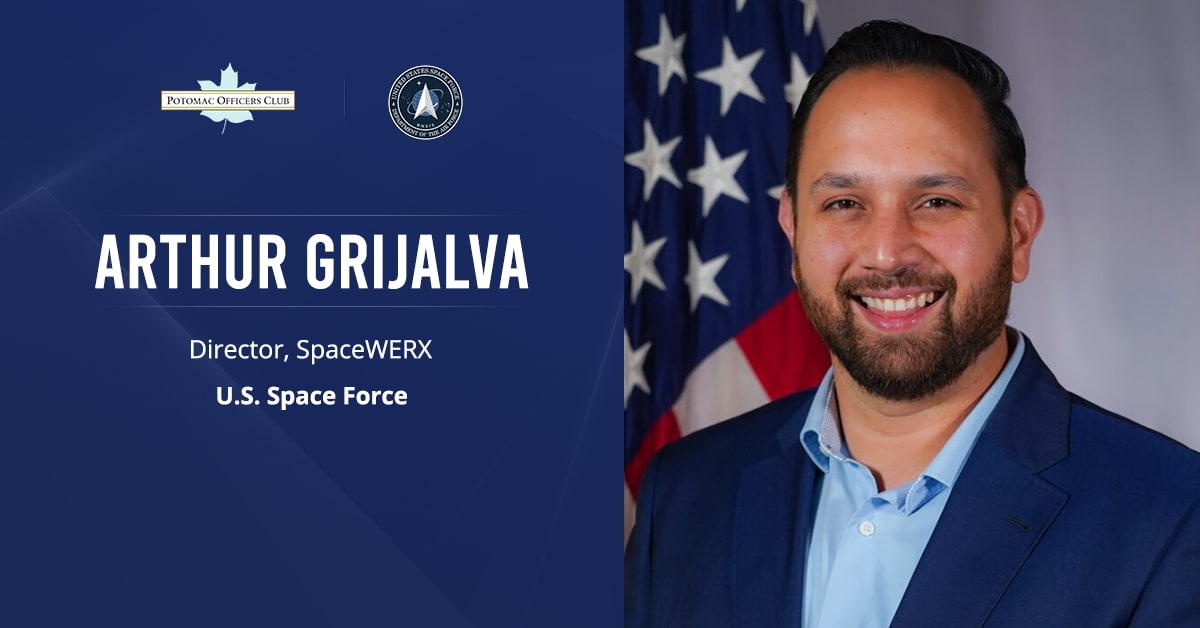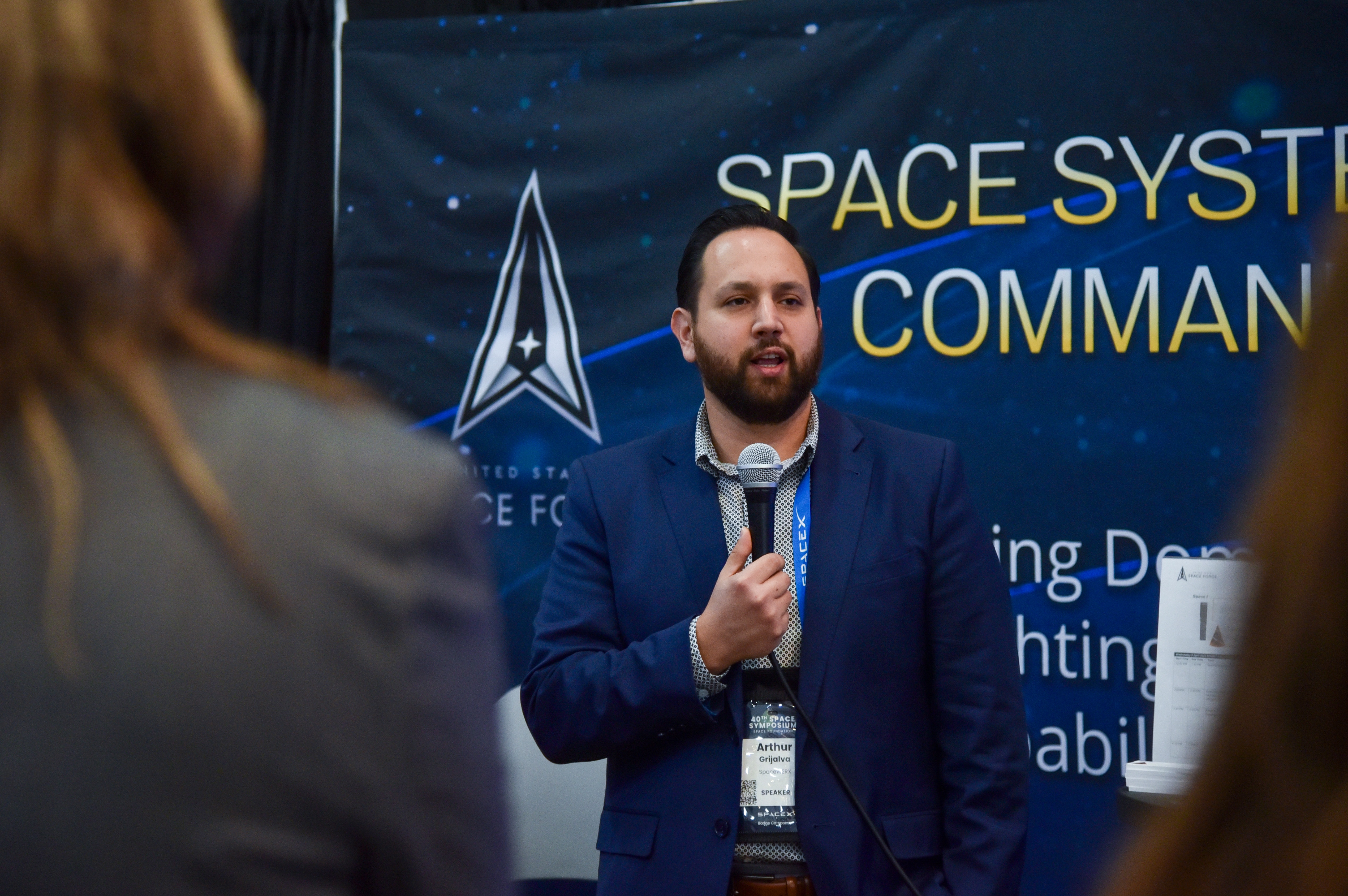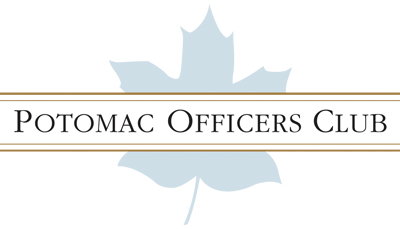
SpaceWERX’s Arthur Grijalva on Contracting Innovation, Orbital Prime
Arthur Grijalva wants to make it easier for small businesses to deliver paradigm-shifting space technologies to DOD. As the SpaceWERX director, Grijalva manages a $470 million budget and has helped the organization rebuild the defense industrial base, reform acquisition and field emerging technologies faster.
Grijalva sat down with the Potomac Officers Club for an interview ahead of his appearance at the 2025 Air and Space Summit on July 31. He discussed novel contracting strategies, helping innovative technologies reach the hands of warfighters and lessons learned from SpaceWERX’s Orbital Prime technology transition effort.
Learn more about small business innovation directly from Grijalva during the Mission Integration: A Novel Approach to Driving Warfighter Outcomes panel at the Potomac Officers Club’s 2025 Air and Space Summit this Thursday, July 31! Explore aligning technology, contracts and mission outcomes, and integrating capabilities across missile defense, counter-UAS and all-domain operations. Discover new business opportunities. Strike up partnerships with other GovCon titans. Tickets are extremely limited, secure your seat now before this highly-anticipated GovCon event sells out!
Potomac Officers Club: What’s the status of Space Prime? What’s the next capability or technology you anticipate creating a “Prime” for and when might that open?
Arthur Grijalva: Let me begin by saying thanks for inviting me to speak at the 2025 Air and Space Summit. Before I answer your first question, let me introduce our organization. As a nation, we must accelerate delivery of capabilities at a lower cost to deter potential aggressors, and if necessary, win in a conflict. SpaceWERX is at the forefront of delivering these lower cost capabilities by building pools of vendors to revamp current and future programs of record.
SpaceWERX is the innovation arm of the U.S. Space Force and a dedicated division within AFWERX, where our mission is to accelerate capabilities by empowering collaboration with startups, small businesses, non-traditionals and research institutions. Headquartered in Los Angeles, SpaceWERX is home to a 50-person team of military, civilian and contractor personnel managing a $470 million annual budget. Since joining the Air Force Research Laboratory in August 2021, we’ve awarded more than 1,470 contracts totaling over $1.46 billion—helping rebuild the defense industrial base, reform acquisition and rapidly field emerging technologies.
We also partner closely with Space Systems Command’s Commercial Space Office to align commercial innovation with operational needs. Through AFWERX and SpaceWERX’s management of the SBIR and STTR programs—under America’s Seed Fund—we’re creating real pathways for innovative technologies to make it into the hands of guardians and warfighters, strengthening both national security and economic competitiveness.
Since its start in 2023, SpaceWERX’s Orbital Prime program has seeded $141 million to accelerate in-space, servicing, assembly and manufacturing, or ISAM, as an enduring and accessible capability for the U.S. Space Force and nation. The program has led to more than $220 million in venture capital funding as well as 20 on-orbit demonstrations including the high-interest Starfish Space Strategic Funding Increase, or STRATFI, with Space Systems Command’s Assured Access to Space.
Under the STRATFI, Starfish Space is planned to launch in 2026 and conduct autonomous rendezvous and docking maneuvers to service an unprepared satellite in geospatial earth orbit. SpaceWERX continues to monitor the process of the cohort of Orbital Prime companies and collaborate across the Space Force, NASA, the Defense Advanced Research Projects Agency and Defense Innovation Unit to transition these novel ISAM technologies and capabilities.
SpaceWERX has incorporated the lessons learned from the Orbital Prime program to develop cohorts of companies. By uniting acquisition, operations, industry, academia and private capital, SpaceWERX builds mission-focused cohorts to address program executive office and combatant command priorities. These companies receive comprehensive support, including knowledge resources, subject matter expertise, test facilities and networking, with top performers being fast-tracked into Tactical Funding Increases, or TACFIs, and STRATFIs to foster transition.
SpaceWERX does not currently have plans for another Prime program but will establish a new SpaceWERX Prime once the right opportunity and mission is identified.

POC: What dual use technologies that have broadened defense opportunities and expanded Space Force capabilities have been developed as part of SpaceWERX’s work?
Grijalva: SpaceWERX is teaming with programs of record, industry and private capital to build a pool of vendors through programs like TACFI and STRATFI, with the goal of transitioning paradigm-shifting technologies and capabilities to the warfighter. The Space Force is tapping into these vendors to enhance the Geosynchronous Space Situational Awareness Program, or GSSAP, and Regional-Global Positioning System, a.k.a. R-GPS, delivering greater capability at reduced cost with additional efforts in the pipeline.
One example of a dual-use technology supported through SpaceWERX is a new class of large satellite buses designed to increase the resiliency and affordability of space-based systems.
Developed through the Tactically Responsive Space Challenge, these “mega-class” satellite buses are built to carry 1,000 kg in payloads, deliver 10-times the power of traditional platforms and integrate with a range of launch vehicles—enabling rapid deployment and greater flexibility in orbit. At just $15 million each, these satellites cost a tenth of comparable vehicles in their class, which typically run $150 million.
This approach aligns with national defense strategies prioritizing “deterrence by resilience” and addresses the growing need to replenish and augment satellite constellations in contested environments. By leveraging commercial launch advancements and low-cost manufacturing techniques, the system provides a scalable way to deliver a more redundant and survivable space architecture.
The technology has advanced rapidly through the SpaceWERX SBIR/STTR pipeline and received follow-on support through STRATFI, with a launch demonstration currently scheduled for early 2026. This progress highlights how dual-use innovations can be tailored to meet urgent defense needs while also expanding commercial space capabilities.
Discover Grijalva’s plans for his $470 million SpaceWERX budget at the Potomac Officers Club’s 2025 Air and Space Summit this Thursday, July 31! Learn about DOD’s acquisition strategy for its massive Golden Dome homeland missile defense program. Hear directly from the U.S. Space Force’s acquisition director, Maj. Gen. Stephen Purdy, about new space requirements and spending priorities. Secure your seat today before tickets sell out!
POC: What are some critical technologies for which you expect to release topic award solicitations in the next 12 months?
Grijalva: Over the next year, SpaceWERX will release a series of topic award solicitations focused on space warfighting and maintaining space superiority. These priorities are informed by recent SpaceWERX Challenges—open competitions that invite industry, academic and government partners to propose innovative, dual-use solutions for national security.
We’re really focused on space-based interceptors for missile defense, resilient military communications, next-gen space warfighting, AI and machine learning for space operations and advanced manufacturing.
All these focus areas show our commitment to teaming up with commercial innovators to deliver scalable and mission-ready tech. By fast-tracking critical space capabilities, SpaceWERX is helping the U.S. stay ahead and keep its edge in space operations.
POC: What is SpaceWERX doing to embrace innovative contracting methods and help small and non-traditional companies do business with the USSF?
Grijalva: At SpaceWERX, we’re all about making it easier for small and non-traditional companies to work with the U.S. Space Force by using smarter, faster contracting methods. Take our Sustained Space Maneuver Challenge, for example. We awarded $1.9 million in Direct to Phase II SBIR contracts to 10 companies. This process cuts down on red tape and speeds up funding, so promising tech gets into the hands of the warfighter much quicker. Plus, it was the first challenge launched by a combatant command, U.S. Space Command J8, showing how seriously we take getting innovative solutions out there fast.
We also run the Innovate to Accelerate, or I2A workshop—a 12-week program that helps companies better understand what the warfighter really needs. This helps them fine-tune their solutions to be more useful and responsive, making the Space Force more agile overall.
On top of contracts and funding, we host plenty of events like networking mixers, pitch sessions and workshops. These are designed to break down barriers and give innovative companies a direct line to Space Force stakeholders. If you want to stay in the loop on upcoming events and opportunities, check out our website at spacewerx.us.
If you’re looking for even more ways to engage with the broader Space Systems Command community, the SSC Front Door is another great resource. It’s designed to guide industry, academia and government partners through the process of connecting with the right stakeholders, helping you navigate collaboration and acquisition pathways with SSC.
POC: Reflect on the Program Year 24.2 STRATFI selections. How have those companies and the technologies they are developing progressed since contract award selections in August 2024? Do you anticipate creating any new programs similar to this effort in the next 12 months?
Grijalva: Since the Program Year 24.2 STRATFI awards in August 2024, the selected companies have been working closely with Space Force stakeholders to refine their technologies and move them closer to operational use. For Program Year 24.2, SpaceWERX selected eight STRATFIs totaling $440 million in funding—$100 million from SpaceWERX and the remainder from matching government and private capital.
These STRATFIs are hitting key milestones, showing measurable progress and ensuring their solutions stay aligned with evolving defense priorities. The goal is to move beyond prototyping and into full-scale implementation, bridging the gap between Phase II and Phase III of the SBIR Process.
Our STRATFI program supports this transition by providing $60 million or more through a partnership model: $15 million from SpaceWERX, $15 million from programs of record and $30 million in private capital. The program is open to small businesses with Phase II contracts awarded within the past two years, and companies apply through an annual notice of opportunity. Beyond the funding, STRATFI connects innovators with defense leaders, primes and investors to accelerate development, testing and adoption.
We expect programs like STRATFI to remain a vital part of our strategy to advance high-impact technologies and capabilities. The next notice of opportunity—Program Year 26.1—is set to open in late July 2025, giving more small businesses the chance to scale their innovations and support the Space Force mission. We are currently considering allowing companies to receive a second STRATFI and increasing SpaceWERX funding to further enable transition into programs of record supporting high-priority Space Force missions.

Category: Articles





